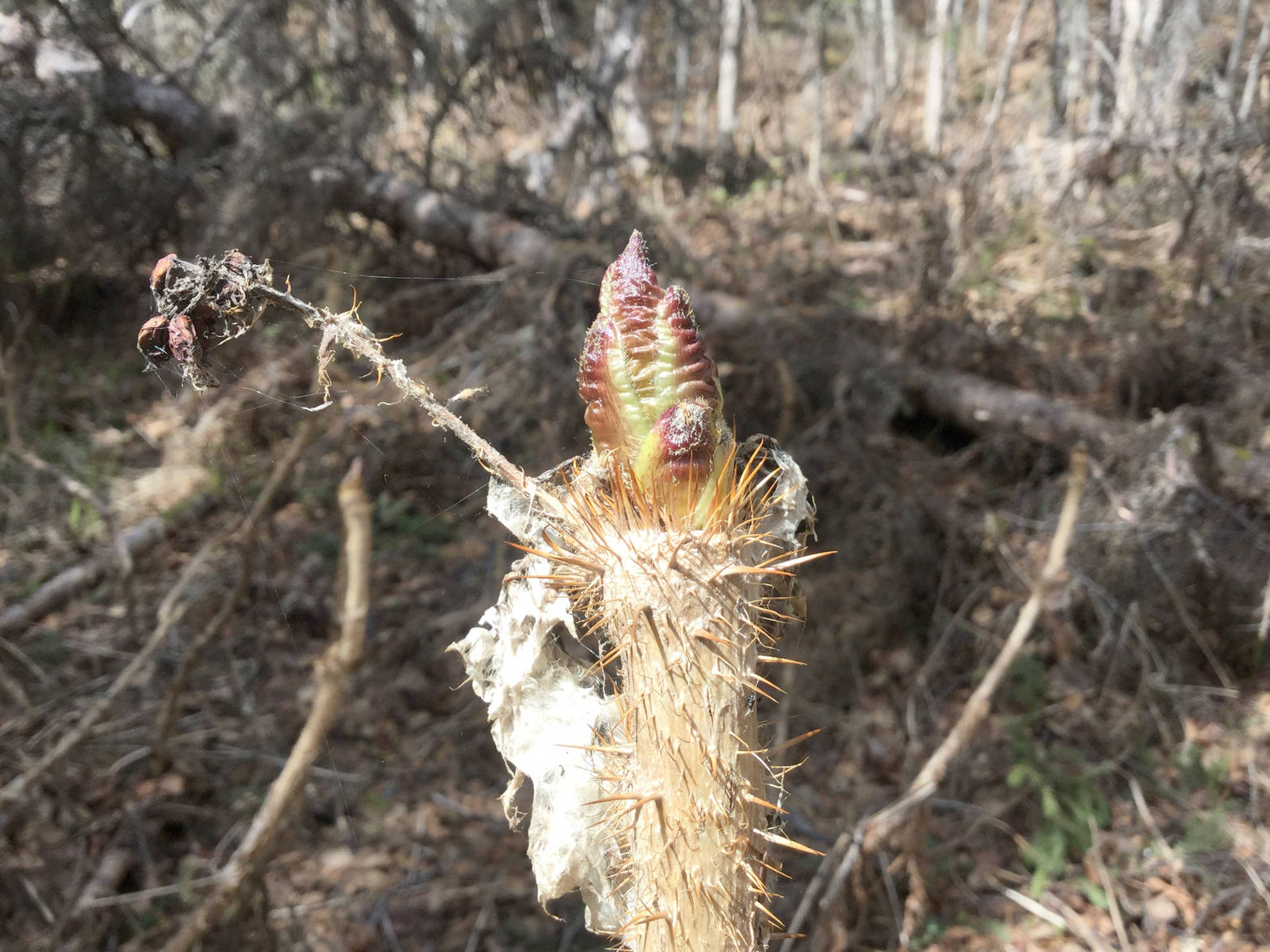If your only interactions with devil’s club have involved needle-sharp prickles poking into your legs, arms or hands, then I can understand your disdain for this plant. I enjoy getting poked no more than anyone else, but I truly do like devil’s club.
As a black bear endures stinging yellow jackets to get at a nest full of protein-rich larvae, I put up with those devil’s club prickles because it is worth the trouble. I think of it like a pineapple — prickly on the outside but good on the inside.
Devil’s club has long been regarded as a useful medicinal plant by the Outer Inlet Dena’ina, who know it as heshkeghka’a (literally “big, big prickle”). The Dena’ina prepared a tea from the inner bark of the roots to treat infections, fever, tuberculosis, coughs and colds.
A topical treatment from the root bark was used for boils, sores and topical infections. Beyond the Kenai Peninsula, devil’s club was likely the most important medicinal and spiritual plant to most indigenous peoples in the Pacific Northwest wherever the plant occurs. A 2004 article in the journal HerbalGram listed 34 broad categories of medicinal uses by 38 linguistic groups of indigenous peoples in the Northwest.
In recent years, devil’s club root and extracts from devil’s club have been increasingly marketed in the herbal and dietary supplement industry as “Alaskan ginseng” or “Pacific ginseng,” suggesting similarities to ginseng, to which devil’s club is closely related.
However, the chemical makeup of devil’s club differs from that of ginseng, so it cannot be assumed that the two plants have similar medicinal uses. At this point the pharmacology of devil’s club has not been thoroughly investigated, but there is evidence that some components of extracts from devil’s club have antimicrobial and anticancer properties.
I do not take devil’s club medicinally, but I do harvest the buds every spring to eat in soups, stir fry and pesto. They have an excellent, unique, strongly aromatic flavor. I think they are best used like cutting celery tops — a little too strong to eat much by itself but wonderful as a flavorful component of a meal.
The spring buds are typically ready for harvest as they are just starting to expand in the middle of May. The key is to catch them after they have expanded beyond the surrounding bracts and before the prickles begin to harden — typically a one- to two-week window just after the fern fiddleheads have begun to unfurl.
Like when harvesting pineapples, wear sturdy pants, a long-sleeved shirt, good boots, leather gloves and eye protection. The buds can simply be pinched off by gloved hands and placed into a basket.
At home, the buds should be separated from any hardened prickles, bits of branches and other debris. I usually (but not always) remove the purplish, slightly papery bracts on the outside of each bud. The cleaned buds can be used fresh in stir fry or pesto, or served blanched with butter as a side dish.
To preserve devil’s club buds I either dehydrate them or blanch and freeze them. Dehydrated buds are easiest to store and work especially well for soups. For freezer storage, the buds must first be blanched for two minutes or so by steaming or placing them in boiling water. Otherwise they will turn brown when frozen. I think they would be great pickled like artichoke hearts, but I have not tried this yet.
Devil’s club is also important to wildlife. A study on the lowlands of the Kenai National Wildlife Refuge in the 1980s found that the berrylike fruits of devil’s club were the most important food for black bears in summer and fall.
In late summer, black bears migrated to mature forests where devil’s club grows. In these forests, fruits of devil’s club were present in 90 to 100 percent of bear scat and made up more than 70 percent of the bears’ diets, providing ample nutrition for the bears to overwinter.
Devil’s club’s broad foliage provides shade and cover over salmon streams. Birds and small mammals use devil’s club for protection. The inconspicuous, greenish flowers are highly attractive to pollinating insects.
I encourage you to get to know devil’s club a little better and learn to appreciate it. The lush, green foliage and contrasting, bright red fruits have led to intentional planting of devil’s club as an ornamental. I think it is beautiful, but I still choose to walk around it when I am trying to get somewhere in the woods. Fittingly, Devil’s club has been considered for use as a natural and visually appealing security barrier to deter people from walking through sensitive areas.
Matt Bowser serves as Entomologist at the Kenai National Wildlife Refuge. Find more information at http://www.fws.gov/refuge/kenai/ or http://www.facebook.com/kenainationalwildliferefuge.

